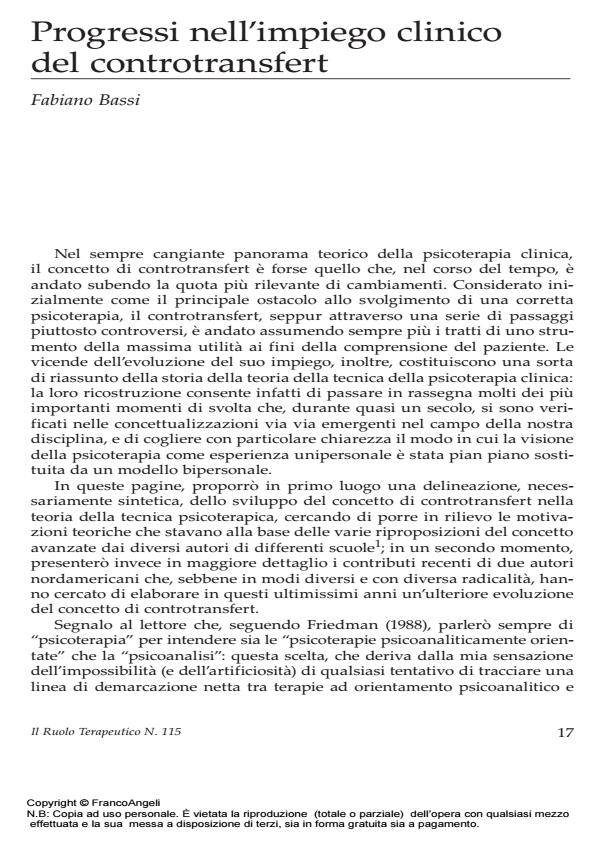Progress in the clinical use of the countertransference
Journal title RUOLO TERAPEUTICO (IL)
Author/s Fabiano Bassi
Publishing Year 2010 Issue 2010/115
Language Italian Pages 22 P. 17-38 File size 387 KB
DOI 10.3280/RT2010-115003
DOI is like a bar code for intellectual property: to have more infomation
click here
Below, you can see the article first page
If you want to buy this article in PDF format, you can do it, following the instructions to buy download credits

FrancoAngeli is member of Publishers International Linking Association, Inc (PILA), a not-for-profit association which run the CrossRef service enabling links to and from online scholarly content.
The concept of countertransference has perhaps changed most over time, so much so that it can be used to sum up the story of psychotherapeutic technique. Freud speaks of it for the first time at the Nuremberg Congress, as an obstacle to good psychotherapeutic progress, so much so that he proposed, in order to remove inauspicious effects, first of all the therapist’s autoanalysis followed by didactic analysis. Only in 1912 he opens up to seeing it as a useful tool for the therapist to tune his own subconscious with that of the patient. After which he never speaks to it again. The controversy is taken up again after his death by Anna Freud and the founders of Ego Psychology and by Melanie Klein. The first propose themselves as vestals to Freud’s heredity and continue to see it as a sign of some dysfunction in the therapist. The second, and more precisely her student and patient, Paula Heimann, on the contrary emphasizes the importance of the feelings of the therapist for better understanding the patient. Another author who is in favour of its use was the Kleinian Racker. He established the bases for the development of the bipersonal model of psychotherapy. Another contribution, even if indirect, comes from Kohut who underlines the importance of empathy as a principal therapeutic factor. Then there is Sandler who considers it a mix between the characteristics of the therapist and the requests of the patient. Jacobs, introduces the concept of "countertransferential enactment" to signal a phenomenon similar to the "acting out" of the patient. And Renik underlines the inestimable importance of self revelation by the therapist for the patient, as long as these are respectful and opportune, to help him to work more efficaciously on the transference relationship.
Keywords: transference, countertransference, countertransferential enactment, confrontation, empathy
Fabiano Bassi, Progressi nell’impiego clinico del controtransfert in "RUOLO TERAPEUTICO (IL)" 115/2010, pp 17-38, DOI: 10.3280/RT2010-115003